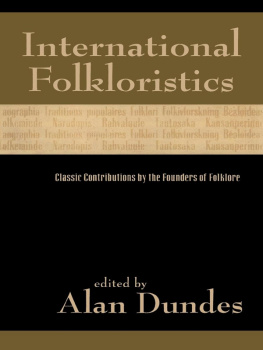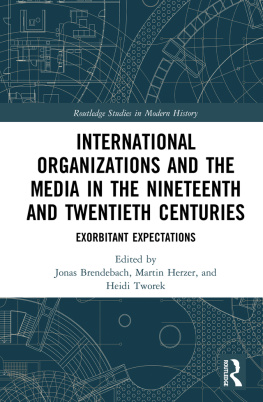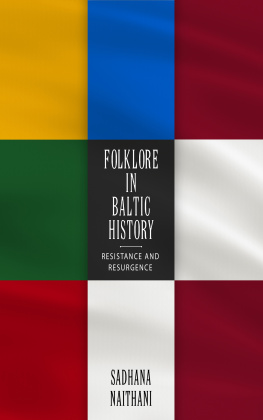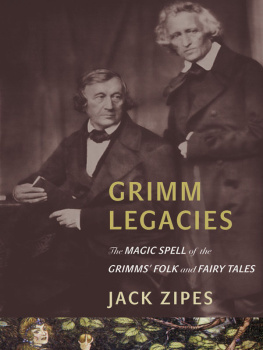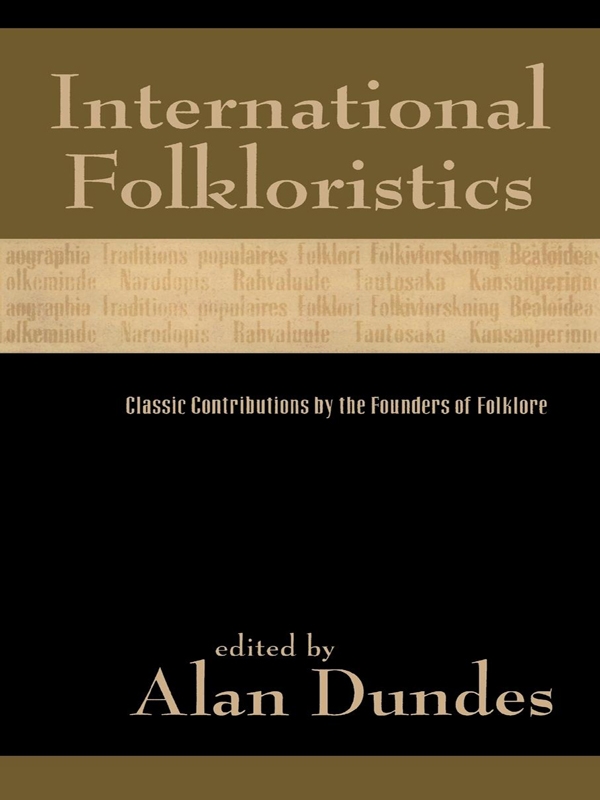Acknowledgments
First, I am deeply indebted to Dean Birkenkamp, executive editor of Rowman & Littlefield, for his original inquiry that led to the planning of this volume. Second, I must express my gratitude to Jo Lynn Milardovich and her associates in the Interlibrary Borrowing department of Doe Library at the University of California, Berkeley, for their uncanny ability to locate fugitive and arcane sources for this and for my other research projects over the years. Several of the items in this volume would not have been included had I not had the benefit of their invaluable expertise and assistance. And third, I want to thank those publishers who were kind enough to grant permission to reprint the essays I selected.
Jacob Grimms Circular, Die Sammlung der Volkspoesie Betreffend, dated 1815, was reprinted in Grimms Kleinere Schriften, Vol. 7 (Berlin: Ferd. Dmmlers Verlagsbuchhandlung, 1884), 593-595. It was first called to my attention in 1974 by Dr. Ruth-Inge Heinze who made an initial translation for me. The present translation from German to English was made by Johanna Micaela Jacobsen and Alan Dundes.
William Thomss classic proposal of the term Folk-Lore first appeared in the Athenaeum, No. 982 (August 22, 1846):862-863. His note Origin of the Word Folk-Lore was published in Notes and Queries, 4th Series, Vol. 10 (October 26, 1872):339-340.
Wilhelm Mannhardts questionnaire was translated from the French Demande, Bulletin de la Socit ligeoise de litterature wallonne 7(2) (1864):10-17, and supplemented with a few details from the German Bitte, which appeared in Die Korndmonen (Berlin: Ferd. Dmmlers Verlagsbuchhandlung, 1868), 44-48. The translation was made by Johanna Micaela Jacobsen and Alan Dundes.
Reinhold Khlers Ein Engel Flog Durchs Zimmer first appeared in Germania 10 (1865):245-246. It was translated by Johanna Micaela Jacobsen and Alan Dundes.
Max Mllers The Study of Folk-Lore appeared in The Academy 21 (March 18, 1882):193.
Kaarle Krohns La mthode de M. Jules Krohn was published in Congrs International des Traditions Populaires (Paris: Bibliothque des Annales conomiques, 1891), 64-68. It was translated from French into English by Alan Dundes.
W. B. Yeatss The Message of the Folk-Lorist first appeared in The Speaker 8 (August 19, 1893):188-189.
Giuseppe Pitrs Sur La Necessit dune Bibliographie des Traditions Populaires was first published in Congrs International des Traditions Populaires (10-12 Sept. 1900) (Paris: Librairie Maisonneuve, 1902), 4-6. It was translated from French by Alan Dundes.
Bla Bartks letter to Stefi Geyer of August 16, 1907, A Dialogue in Gyergy-Kilnyfalva, was published in Jnos Demny, ed., Bela Bartk Letters (New York: St. Martins, 1971), 70-74.
Boris Sokolov and Yuri Sokolov, In Search of Folktales and Songs, is reprinted from Felix J. Oinas and Stephen Soudakoff, eds., The Study of Russian Folklore (The Hague: Mouton, 1975), 13-22. It was translated from Skazki i pesni Belozerskogo kraja (Moscow: A. I. Snegirevoi, 1915), i-viii, by Stephen Soudakoff assisted by Professor Felix Oinas of Indiana University.
Axel Olriks Epic Laws of Folk Narrative is reprinted from Alan Dundes, ed., The Study of Folklore (Englewood Cliffs: Prentice-Hall, 1965), 129-141. It appeared originally as Epische Gesetze der Volksdictung, Zeitschrift fr Deutsches Altertum 51 (1909):1-2, and was translated from German into English by Jeanne P. Steager.
Arnold van Genneps The Rites of Passage is a brief excerpt from the English translation of his 1909 Les Rites de Passage, published in 1960 as The Rites of Passage (Chicago: University of Chicago Press, 1960), 10-13, plus his conclusions, 189-194. The translation from French into English was made by Monika B. Vizedom and Gabrielle L. Caffee.
James George Frazers The Principles of Sympathetic Magic is reprinted from the third edition of The Golden Bough: A Study in Magic and Religion , Vol. 1 (London: Macmillan, 1913), 52-54.
Vladimir Propps The Structure of Russian Fairy Tales is reprinted from the second English-language edition of his 1928 Morfologija skazki. It is the short second chapter of Morphology of the Folktale, 2d ed. (Austin: University of Texas Press, 1968), 19-24. The first edition, published in 1958, was translated by Laurence Scott, and the second edition was revised and edited by Louis A. Wagner.
Antonio Gramscis Observations on Folklore is reprinted from Antonio Gramsci, Prison Notebooks, Vol. 1 (New York: Columbia University Press, 1992), 186-187, 487-488. It is paragraph or section number 89 and was probably written circa 1929. It was translated from Italian by Joseph A. Buttigieg and Antonio Callari.
Carl Wilhelm von Sydows Geography and Folk-Tale Oicotypes is reprinted from C. W. v. Sydow, Selected Papers on Folklore (Copenhagen: Rosenkilde and Bagger, 1948), 44-59, 243-244. It was originally published in Beloideas 7 (1932):346-355.
Samus Duileargas Irish Tales and Story-Tellers is reprinted from Hugo Kuhn and Kurt Schier, eds., Mrchen, Mythos, Dichtung: Festschrift zum 90. Geburtstag Friedrich von der Leyens am 19. August 1963 (Munich: Verlag C. H. Beck, 1963), 63-82, with one small addition taken from the earlier, longer original version of the essay, The Gaelic Story-Teller, Proceedings of the British Academy 31 (1945):177221.
Sigmund Freuds Symbolism in Dreams is reprinted from Sigmund Freud, A General Introduction to Psychoanalysis (New York: Permabooks, 1953), 156-177. The translation from German to English was made by Joan Riviere.
Gza Rheims Wedding Ceremonies in European Folklore is reprinted from Samiksa 8 (1954):137-173. The article was originally written in Hungarian, but Rheim himself rewrote it in English.
Kenneth S. Goldsteins Strategy in Counting Out: An Ethnographic Folklore Field Study is reprinted from Elliott M. Avedon and Brian Sutton-Smith, eds., The Study of Games (New York: John Wiley, 1971), 167-178.
About the Editor
Alan Dundes is known as one of the worlds leading authorities on folklore. In more than thirty books he has unveiled the meanings in the oral traditions of many cultures. He lives in Berkeley, where he is professor of anthropology and folklore at the University of California.
Suggestions for Further Reading in the History of Folkloristics
No comprehensive history of international folkloristics offers worldwide coverage of the discipline. One is therefore forced to rely on histories of folkloristics limited to nations, to groups within nations, or to individual folklore genres, each of which has its own history of scholarship. Listing historical surveys of folkloristics in every country of the world, covering every folk group in those countries, would be a gigantic task, even assuming one had the polyglot expertise to do so. The following list is intended to be a selected bibliography of sources for anyone with a serious interest in the history of folkloristics. With a few exceptions the list is limited to national surveys of folkloristics, and it is by no means exhaustive. It should, however, give some indication of how widespread the interest in folkloristics is as well as some idea of how long folklorists have been engaged in recording and analyzing folklore.
Acosta Saignes, Miguel. 1967. Materiales para la historia del folklore en Venezuela, Archivos Venezolanos de Folklore 8:5-27.
Azadovski, Mark. 1933. The Science of Folklore in the USSR, KOKS 4:39-60.
Azadovskii, Mark. 1958. Istoriia russkoi folkkloristiki. 2 vols. Moscow: Uchpedgiz.
Balys, Jonas. 1935. A Short Review of the Collection of Lithuanian Folk-Lore, Tautosakos Darbai 1:1-26.

